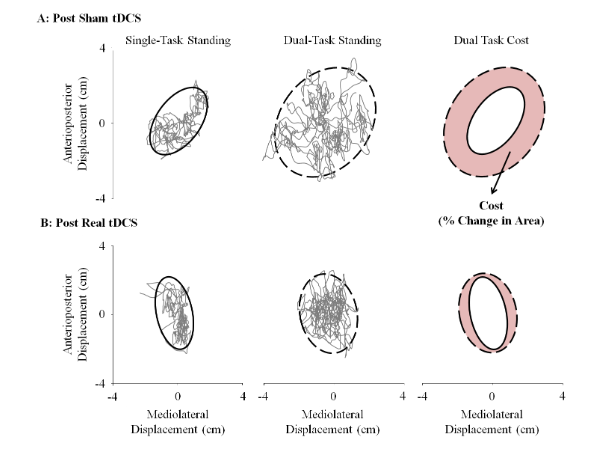When standing or walking, we often perform additional cognitive tasks such as talking, reading or listening to a friend. This “dual tasking” is critical to the completion of activities of daily living. Dual-tasking often results in reduced performance in one or both tasks, especially in older adults. The observation that dual tasking comes at a “cost” to performance means that the involved tasks use shared brain networks. Strategies designed to increase brain network excitability and/or efficiency thus hold great promise to improve dual task capacity across the lifespan. Transcranial direct current stimulation (tDCS) is one safe and non-invasive method that uses low-level electrical currents to temporarily change brain excitability. The purpose of this experiment was to determine the immediate effects of tDCS on dual task balance performance in older adults.
Thirty-seven adults aged 60-85 years completed two laboratory visits separated by one week. They received 20-minutes of tDCS during each visit. On one visit, they received tDCS designed to increase the excitability of the left dorsolateral prefrontal cortex—a region closely linked to cognition and motor control. On the other visit, they received “sham,” (i.e. placebo) stimulation. Participants and study personnel were blinded to tDCS condition. Before and after each tDCS session, participants completed a dual task paradigm comprising trials of standing and walking both with and without performance of a mental arithmetic task. The Figure below illustrates the effects of tDCS on single- and dual-task standing postural sway in a selected participant. Results indicated that real tDCS reduced the dual task cost to both standing postural sway area and walking speed compared to sham stimulation. It also effectively mitigated the cost of walking on performance within the serial subtraction task. Intriguingly, tDCS did not alter standing, walking, or serial-subtraction performance within single task conditions. The reduction in dual task costs was instead spurred by significantly improved performance in each outcome specifically within dual task conditions.
This study demonstrated for the first time that dual tasking performance can be enhanced by modulating prefrontal brain excitability using non-invasive electrical brain stimulation. These results suggest that following just 20 minutes of stimulation, older adults may be able to more safely stand and walk while completing additional, unrelated cognitive tasks. These results also suggest that the cost of dual tasking is not a fixed, obligatory consequence of aging, and identify tDCS as a novel approach to preserving dual tasking and balance into old age.

Publication
Manor B, Zhou J, Jor’dan A, Zhang J, Fang J, Pascual-Leone A. (2016). Reduction of dual-task costs by noninvasive modulation of prefrontal activity in healthy elders. Journal of Cognitive Neuroscience. Doi: 10.1162/jocn_a_00897.
https://www.ncbi.nlm.nih.gov/pubmed/26488591
About the Author

Brad Manor, PhD
Assistant Professor of Medicine, Harvard Medical School
Brad Manor is the Director of the Mobility and Brain Function Research Program at Hebrew SeniorLife’s Institute for Aging Research and Harvard Medical School. His research combines brain imaging, non-invasive brain stimulation, and advanced signal processing techniques to understand and enhance the neural control of balance in aging and disease.
Copyright
© 2018 by the author. Except as otherwise noted, the ISPGR blog, including its text and figures, is licensed under a Creative Commons Attribution-ShareAlike 4.0 International License. To view a copy of this license, visit https://creativecommons.org/licenses/by-sa/4.0/legalcode.
ISPGR blog (ISSN 2561-4703)
Are you interested in writing a blog post for the ISPGR website? If so, please email the ISGPR Secretariat with the following information:
- First and Last Name
- Institution/Affiliation
- Paper you will be referencing
